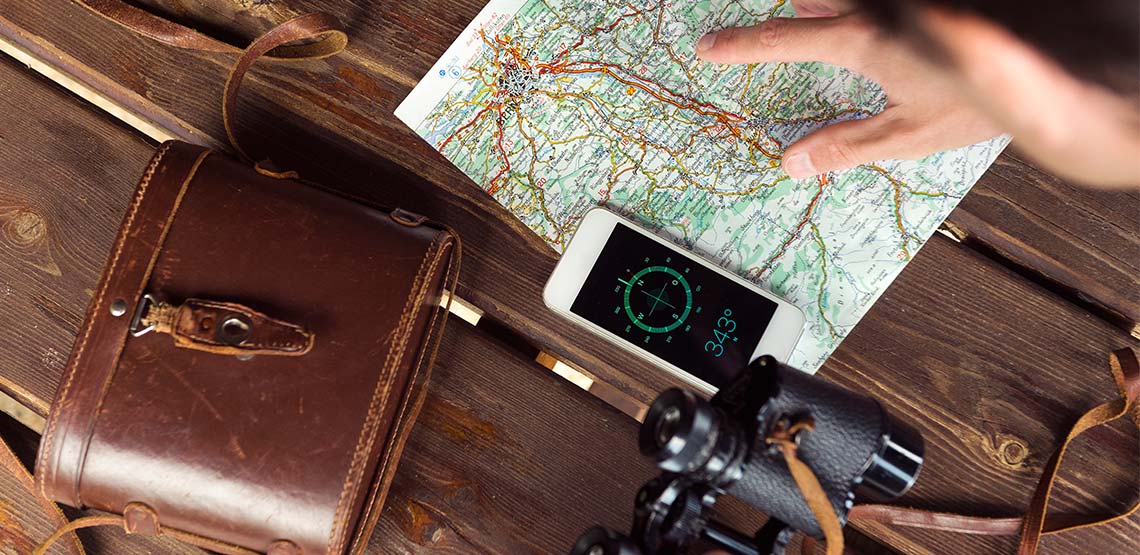Essential Outdoor Skills: How to Use a Compass
A GPS Doesn’t Always Cut It
Although most travelers use a GPS or similar device for navigation these days, there are still instances when a traditional compass can come in handy. When backpacking and hiking in remote areas and backcountry, where no GPS or cellphone signal exists, using a compass can actually save your life, especially when traveling alone. If you find yourself lost on a trail or in the woods, knowing how to use a compass can ensure that your hiking experience doesn’t become a stressful one — or a life or death situation.
However, as with any piece of equipment, it’s essential to learn the ins and outs of what the device is and how to use it properly.
What Is a Compass?
A compass, quite simply, is a tool that is used to provide direction and navigation. Most of what people think of when they think “compass” is actually a magnetic compass, which is the earliest type of compass that we know of (likely discovered by the ancient Chinese nearly 2,000 years ago). Early magnetic compasses included a magnetized needle and a piece of wood or cork suspended in water. When magnetized, the needle would point toward the north and south poles.
Later on, compasses evolved to show the cardinal directions, or what were deemed the most important directions based on the movements of the sun in the sky. They also became more sophisticated in their construction, often enclosed in a metal casing, but always with the same basic, critical components using the Earth’s natural magnetism.
While now there are different kinds of compasses with different features, most at least consist of:
- North label — on some compasses, the north label will be larger than the label for other directions
- Cardinal directions and/or 360-degree measurements
- Magnetic needle with a red end that always points north
Modern compasses may also include:
- Baseplate with a straightedge for taking bearings
- A ruler to measure distance
- Direction-of-travel arrow — where to point your compass when traveling or getting your bearings
- Rotating bezel
Types of Compasses
Selecting a compass should be based on your personal needs, but also what feels most natural and intuitive to you. There are a variety of compass styles available on the market, including but not limited to the following:
Baseplate Compass
This is one of the most common and affordable types of compasses. The liquid-filled compass affixes to a rectangular base that is usually made of clear plastic. The baseplate also sometimes includes a magnifying lens for map reading, lucid components for easy reading in low-light conditions, and varying scales for use all over the world.
The baseplate compass is useful for plotting purposes and suitable for beginners, but it doesn’t contain advanced sighting features, which can make it a challenge to sight toward a distant object.
A great option for a basic baseplate compass is this Boy Scout Compass.
Mirror Compass
Mirrored compasses are used for sighting long distances. In addition to a baseplate, these compasses have an attached mirror that is positioned at a 45-degree angle. Because you can see both the compass dial and the background at the same time, you can get more accurate bearings with mirror compasses.
A great option for a mirror compass is the Suunto MC-2G.
Thumb Compass
Also known as competition compasses for their use in competitive orienteering, thumb compasses attach to the user’s thumb (as its name implies), which enables them to hold both the map and the compass in one hand while continuing to progress on foot, bike or canoe.
They’re a much quicker compass for advanced users, but as they have minimal or no degree markings, and are mainly used to get a magnetic north map bearing, they’re not usually recommended for beginners.
A great option for a thumb compass is this Elite Thumb Orienteering Compass.
Electronic Compass
These compasses provide your bearings via a numerical readout. The readings are quite accurate and include a number of unique features, including the option to store your bearings in the memory. You can also be notified if you wander off course. Unfortunately, electronic compasses are not the best suited for map work as they require a power source.
Using a Compass to Navigate an Area
When determining the direction you need to travel, or the bearing, to get from point A to point B, there are a few basic steps you need to take.
First is holding a compass correctly. It should lay flat on the palm of your hand or another flat surface in order to get an accurate reading. When holding the compass, you can find out the direction you’re currently facing by looking at the magnetic needle. You can swing your hand around with the compass until you see the magnetic needle pointing to the “N” for north, in order to find north.
If your compass has a degree dial, you can also turn it until the orienting arrow lines up with the magnetic arrow, getting them both to point north, and then look at the direction of travel arrow to see where it falls. For an even more accurate reading, look at the degree markers on the compass to see how many degrees in a direction you are facing.
Once you find the direction you want to go in, continue moving in that direction, taking care to check that the compass is still pointing in the right direction along the way. It’s a good idea to take readings periodically when hiking or traveling in an unfamiliar area to ensure you keep heading in the right direction.
Another way to help you use a compass to navigate is by determining focus or attack points. Once you determine the direction, find a distant object in your path and use it as a guide. Get a new bearing once you reach it, and then repeat the whole process with a new focus point.
It’s also smart to practice with your compass before a trip, in a well-known area, before venturing to a more challenging trail or location that you have not oriented to in the past.
Whether you're looking for a family adventure or an adrenaline-infused excursion, whitewater rafting Colorado has the trip for you. Here's what to know!
Orienteering
Another way to use a compass is with a map, also called orienteering. It can be done for leisure, to explore a new area at your own pace, or to hone navigational skills, but orienteering is also a competitive sport. Whatever your reason for learning how to use a compass and map, these tips will get you where you need to go.
One of the first things you’ll need to do when orienteering is find out where you are and where you want to go. Finding where you are can be done by looking for familiar landmarks on a map that you can see around you. Once you have a general idea of your location on a map, decide where you want to go. From there, you’ll have a line of travel that you can then follow with your compass.
Place your compass on the map and line up the edge with your line of travel from point A to point B. From there, you rotate the bezel until the north arrow is parallel and pointing in the same direction as the north arrow on the map. This is also how you figure out the angle in degrees that your current location is from point B, in addition to the specific direction.
Now that you have set your compass to the right degree, turn your compass until the red magnetic needle is within the red orienting arrow. (You can either take your compass off the map at this point or keep it placed in the same position on the map and turn the map along with it.) Then turn your body and square yourself to the direction of travel arrow. This is the direction you will be walking in.
A simple strategy to keep track of your location on the map is to position your thumb on your present location. As you progress through the terrain, adjust your thumb too so you can reliably pinpoint exactly where you are located.
You’ll also want to ensure you keep your map facing the direction of travel by using the north mark or compass rose on the map and turning the map in the appropriate direction.
Check out this video for a full explanation on how to use a compass with a map.
Understanding True North
The concept of true north can be a bit confusing, especially because compasses don’t always point to true north. Thus, it is important to understand what true north really means and how to compensate with your compass.
The compass needle is pulled by magnetic force, which varies in different parts of the world and is constantly changing. When you read north on a compass, you’re really reading the direction of the magnetic north pole.
This variance between true north and the north heading on your compass is referred to as declination. Because the Earth’s magnetic field varies, declination also varies from place to place. These variations in the magnetic field can result in a compass needle pointing away from both the geographic North Pole and the magnetic north pole.
The difference between true north and magnetic north can differ by as many as 20 degrees in some locations. When using a compass, you’ll have to account for the magnetic shift to get an accurate reading.
You can correct for declination by either adding the declination if you’re in an area with east declination or subtracting the declination if you’re in an area with west declination. To find out the declination where you are, you can check your map if you’re using one (topographic maps usually have the declination of an area listed) or check the National Oceanic and Atmospheric Administration (NOAA) website (if you’re in the United States) before your trip.
Some compasses also allow you to adjust for declination so you don’t have to do any calculations when you take your reading.
Other Ways Compasses Are Useful
Using a compass is also a great way to orient yourself when traveling, even in big cities. When taking public transportation you may need to figure out which direction you need to catch the bus or the train from. Finding true north with your compass can help you establish whether you are on the right side of the street or track.
Knowing how to use a compass can also help you when exiting from a subway or after visiting someplace for a long time when day has turned into night. In these situations, you may need to literally “get your bearings” to figure out where you are if you’re in an unfamiliar city.
If You Ever Find Yourself without a Compass
While you should always carry a compass with you when hiking or orienteering, sometimes accidents happen, and you may lose or damage your compass. In these cases, you should have some basic knowledge on how to find north without a compass.
To start, locate a sunny area and a large stick. Place the stick directly upright in the ground so you can see the shadow of the stick. Mark the tip of the stick’s shadow with an identifiable pebble. Using your watch, wait for 15 minutes and then mark the new location of the tip of the shadow. The tip of the shadow should be moving from west to east. Mark the new position with another identifiable pebble. Now, draw a line in the ground between the two points.
Next, stand with the first mark on the tip of your left foot (west) and the second mark on the tip of your right foot (east). You should now be facing toward the true north, no matter where you are in the world.
If it is evening and you have lost your way, you can also use the stars to orient yourself toward the north. Many star mapping apps exist that can help you find specific stars and constellations.
Start by locating the North Star in the sky. Also referred to as Polaris, the North Star is the last star in the handle of the Little Dipper. If you are struggling to locate the Little Dipper, start by finding the Big Dipper. The two most distant stars of the cup of the dipper create a straight line that points you in the direction of the North Star.
You may also discover Cassiopeia, which is always located opposite the Big Dipper. The North Star is located about halfway between the middle star of Cassiopeia and the third star in the handle of the Big Dipper.
Using your imagination, draw a line straight down from the North Star to the ground in front of you. This direction is true north. Now, look for an object or landmark in the distance and use that to guide yourself.
In the event that you get lost while hiking or exploring an area, knowing how to navigate is a valuable skill. Hopefully, you’ll always travel with a compass now (most smartphones do have a digital one built in) as knowing how to use a compass is an extremely useful travel and survival skill to have in your arsenal.










